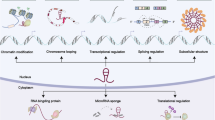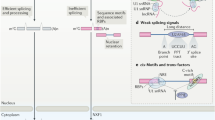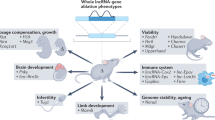Abstract
Recent studies have boosted our understanding of long noncoding RNAs (lncRNAs) in numerous biological processes, but few have examined their roles in somatic cell reprogramming. Through expression profiling and functional screening, we have identified that the large intergenic noncoding RNA p21 (lincRNA-p21) impairs reprogramming. Notably, lincRNA-p21 is induced by p53 but does not promote apoptosis or cell senescence in reprogramming. Instead, lincRNA-p21 associates with the H3K9 methyltransferase SETDB1 and the maintenance DNA methyltransferase DNMT1, which is facilitated by the RNA-binding protein HNRNPK. Consequently, lincRNA-p21 prevents reprogramming by sustaining H3K9me3 and/or CpG methylation at pluripotency gene promoters. Our results provide insight into the role of lncRNAs in reprogramming and establish a novel link between p53 and heterochromatin regulation.
Similar content being viewed by others
Log in or create a free account to read this content
Gain free access to this article, as well as selected content from this journal and more on nature.com
or
Accession codes
References
Takahashi K, Yamanaka S . Induced pluripotent stem cells in medicine and biology. Development 2013; 140:2457–2461.
Liang G, Zhang Y . Genetic and epigenetic variations in iPSCs: potential causes and implications for application. Cell Stem Cell 2013; 13:149–159.
Polo JM, Anderssen E, Walsh RM, et al. A molecular roadmap of reprogramming somatic cells into iPS cells. Cell 2012; 151:1617–1632.
Liu L, Xu Y, He M, et al. Transcriptional pause release is a rate-limiting step for somatic cell reprogramming. Cell Stem Cell 2014; 15:574–588.
Rais Y, Zviran A, Geula S, et al. Deterministic direct reprogramming of somatic cells to pluripotency. Nature 2013; 502:65–70.
Di Stefano B, Sardina JL, van Oevelen C, et al. C/EBPalpha poises B cells for rapid reprogramming into induced pluripotent stem cells. Nature 2014; 506:235–239.
Guo S, Zi X, Schulz VP, et al. Nonstochastic reprogramming from a privileged somatic cell state. Cell 2014; 156:649–662.
Tapia N, Schöler HR . p53 connects tumorigenesis and reprogramming to pluripotency. J Exp Med 2010; 207:2045–2048.
Soufi A, Donahue G, Zaret KS . Facilitators and impediments of the pluripotency reprogramming factors' initial engagement with the genome. Cell 2012; 151:994–1004.
Chen J, Liu H, Liu J, et al. H3K9 methylation is a barrier during somatic cell reprogramming into iPSCs. Nat Genet 2013; 45:34–42.
Sridharan R, Gonzales-Cope M, Chronis C, et al. Proteomic and genomic approaches reveal critical functions of H3K9 methylation and heterochromatin protein-1γ in reprogramming to pluripotency. Nat Cell Biol 2013; 15:872–882.
Mikkelsen TS, Hanna J, Zhang X, et al. Dissecting direct reprogramming through integrative genomic analysis. Nature 2008; 454:49–55.
Subramanyam D, Blelloch R . From microRNAs to targets: pathway discovery in cell fate transitions. Curr Opin Genet Dev 2011; 21:498–503.
Rinn JL, Chang HY . Genome regulation by long noncoding RNAs. Annu Rev Biochem 2012; 81:145–166.
Loewer S, Cabili MN, Guttman M, et al. Large intergenic non-coding RNA-RoR modulates reprogramming of human induced pluripotent stem cells. Nat Genet 2010; 42:1113–1117.
Wang Y, Xu Z, Jiang J, et al. Endogenous miRNA sponge lincRNA-RoR regulates Oct4, Nanog, and Sox2 in human embryonic stem cell self-renewal. Dev Cell 2013; 25:69–80.
Lin N, Chang KY, Li Z, et al. An evolutionarily conserved long noncoding RNA TUNA controls pluripotency and neural lineage commitment. Mol Cell 2014; 53:1005–1019.
Huarte M, Guttman M, Feldser D, et al. A large intergenic noncoding RNA induced by p53 mediates global gene repression in the p53 response. Cell 2010; 142:409–419.
Yoon JH, Abdelmohsen K, Srikantan S, et al. LincRNA-p21 suppresses target mRNA translation. Mol Cell 2012; 47:648–655.
Yang F, Zhang H, Mei Y, Wu M . Reciprocal regulation of HIF-1alpha and lincRNA-p21 modulates the Warburg effect. Mol Cell 2014; 53:88–100.
Silva J, Barrandon O, Nichols J, et al. Promotion of reprogramming to ground state pluripotency by signal inhibition. PLoS Biol 2008; 6:e253.
Guttman M, Donaghey J, Carey BW, et al. lincRNAs act in the circuitry controlling pluripotency and differentiation. Nature 2011; 477:295–300.
Guo X, Liu Q, Wang G, et al. microRNA-29b is a novel mediator of Sox2 function in the regulation of somatic cell reprogramming. Cell Res 2013; 23:142–156.
Montserrat N, Nivet E, Sancho-Martinez I, et al. Reprogramming of human fibroblasts to pluripotency with lineage specifiers. Cell Stem Cell 2013; 13:341–350.
Shu J, Wu C, Wu Y, et al. Induction of pluripotency in mouse somatic cells with lineage specifiers. Cell 2013; 153:963–975.
Choi YJ, Lin CP, Ho JJ, et al. miR-34 miRNAs provide a barrier for somatic cell reprogramming. Nat Cell Biol 2011; 13:1353–1360.
Lee HJ, Hore TA, Reik W . Reprogramming the methylome: erasing memory and creating diversity. Cell Stem Cell 2014; 14:710–719.
Bomsztyk K, Denisenko O, Ostrowski J . hnRNP K: one protein multiple processes. Bioessays 2004; 26:629–638.
Ng SY, Bogu GK, Soh BS, Stanton LW . The long noncoding RNA RMST interacts with SOX2 to regulate neurogenesis. Mol Cell 2013; 51:349–359.
Tuck AC, Tollervey D . A transcriptome-wide atlas of RNP composition reveals diverse classes of mRNAs and lncRNAs. Cell 2013; 154:996–1009.
Di Ruscio A, Ebralidze AK, Benoukraf T, et al. DNMT1-interacting RNAs block gene-specific DNA methylation. Nature 2013; 503:371–376.
Mohammad F, Mondal T, Guseva N, Pandey GK, Kanduri C . Kcnq1ot1 noncoding RNA mediates transcriptional gene silencing by interacting with Dnmt1. Development 2010; 137:2493–2499.
Dimitrova N, Zamudio JR, Jong RM, et al. LincRNA-p21 activates p21 in cis to promote Polycomb target gene expression and to enforce the G1/S checkpoint. Mol Cell 2014; 54:777–790.
Tsai MC, Manor O, Wan Y, et al. Long noncoding RNA as modular scaffold of histone modification complexes. Science 2010; 329:689–693.
Pike KA, Hutchins AP, Vinette V, et al. Protein tyrosine phosphatase 1B is a regulator of the interleukin-10-induced transcriptional program in macrophages. Sci Signal 2014; 7:ra43.
Hutchins AP, Jauch R, Dyla M, Miranda-Saavedra D . glbase: a framework for combining, analyzing and displaying heterogeneous genomic and high-throughput sequencing data. Cell Regen 2014; 3:1.eCollection 2014.
Acknowledgements
We thank all members of the Esteban Lab for their support. This work was supported by the National Basic Research Program of China (973 Program; 2011CB965201 and 2011CBA01106), the Strategic Priority Research Program of the Chinese Academy of Sciences (XDA01020106), the National Natural Science Foundation of China (31371513 and 81202010), the Cooperation Program of the Research Grants Council (RGC) of the Hong Kong Special Administrative Region and the National Natural Science Foundation of China (81261160506), the RGC of the Hong Kong Special Administrative Region, China (476310), the Natural Science Foundation of Guangdong Province (S2013010015487), the Bureau of Science, Technology and Information of Guangzhou Municipality (2012J5100040) and the International Science and Technology Cooperation Program of China (2013DFE33080).
Author information
Authors and Affiliations
Corresponding authors
Additional information
( Supplementary information is linked to the online version of the paper on the Cell Research website.)
Supplementary information
Supplementary information, Table S1
LincRNA expression in 4 cell types and reprogramming (related to Figure 1 and 2, Supplementary information, Figure S1 and S2) (XLSX 29 kb)
Supplementary information, Table S2
RNA-seq gene list (fold change higher than 1.5) at the indicated time points with lincRNA-p21 or Hnrnpk knockdown (related to Figure 5, Supplementary information, Figure S5 and S6). (XLSX 569 kb)
Supplementary information, Table S3
shRNA sequences, primers and antibodies used in this study (XLSX 29 kb)
Supplementary information, Figure S1
Expression of lincRNAs in reprogramming (related to Figure 1) (PDF 153 kb)
Supplementary information, Figure S2
LincRNA-p21 is induced by p53 (related to Figure 2) (PDF 321 kb)
Supplementary information, Figure S3
Comparison of cell proliferation and reprogramming efficiency in reprogrammed MEFs with lincRNA-p21 or/and p53 knockdown and iPSC clone characterization (related to Figure 2) (PDF 455 kb)
Supplementary information, Figure S5
LincRNA-p21 is a subset of HNRNPK function in reprogramming (related to Figure 5) (PDF 1289 kb)
Supplementary information, Figure S6
LincRNA-p21 influences the maturation of let-7 miRNAs but not the expression of mesenchymal or epithelial genes (related to Figure 5) (PDF 391 kb)
Supplementary information, Figure S7
HNRNPK binds to pluripotency genes in reprogramming and lincRNA-p21 regulates CpG methylation at the Nanog promoter (related to Figure 6) (PDF 479 kb)
Supplementary information, Data S1
Extended Materials and Methods (PDF 261 kb)
Rights and permissions
About this article
Cite this article
Bao, X., Wu, H., Zhu, X. et al. The p53-induced lincRNA-p21 derails somatic cell reprogramming by sustaining H3K9me3 and CpG methylation at pluripotency gene promoters. Cell Res 25, 80–92 (2015). https://doi.org/10.1038/cr.2014.165
Received:
Revised:
Accepted:
Published:
Issue date:
DOI: https://doi.org/10.1038/cr.2014.165
Keywords
This article is cited by
-
Non-coding RNA regulation of integrins and their potential as therapeutic targets in cancer
Cellular Oncology (2023)
-
LncRNA LYPLAL1-AS1 rejuvenates human adipose-derived mesenchymal stem cell senescence via transcriptional MIRLET7B inactivation
Cell & Bioscience (2022)
-
5mC and H3K9me3 of TRAF3IP2 promoter region accelerates the progression of translocation renal cell carcinoma
Biomarker Research (2022)
-
CRMP2 derived from cancer associated fibroblasts facilitates progression of ovarian cancer via HIF-1α-glycolysis signaling pathway
Cell Death & Disease (2022)
-
p63 silencing induces epigenetic modulation to enhance human cardiac fibroblast to cardiomyocyte-like differentiation
Scientific Reports (2022)



